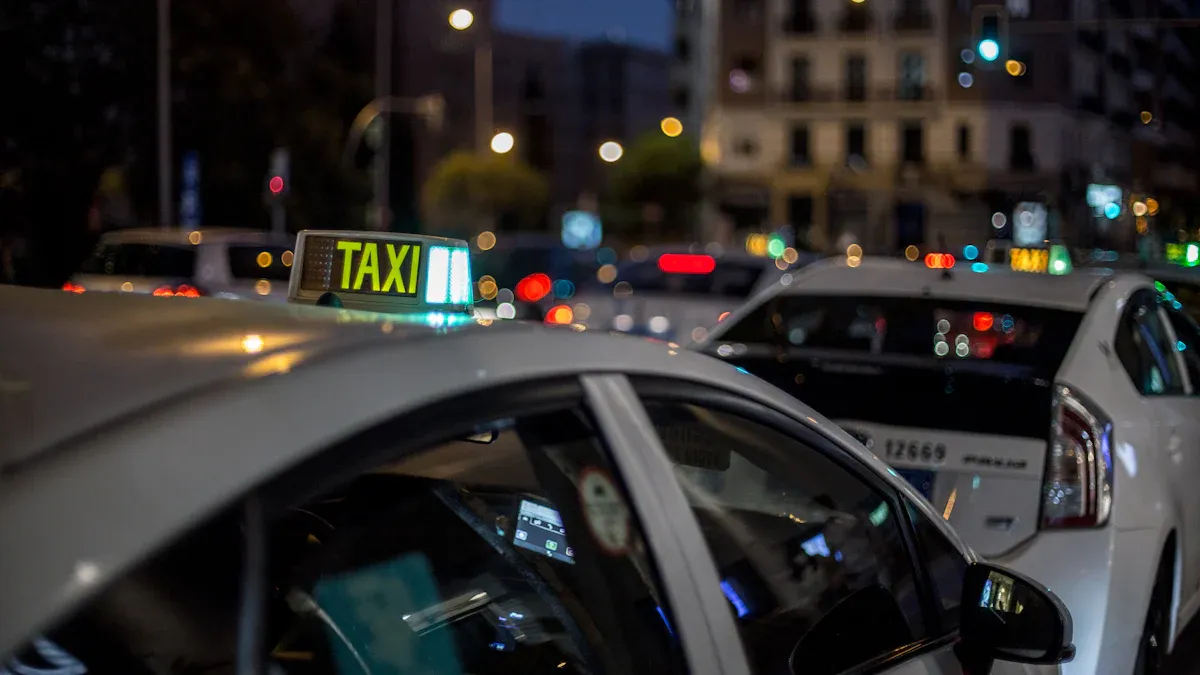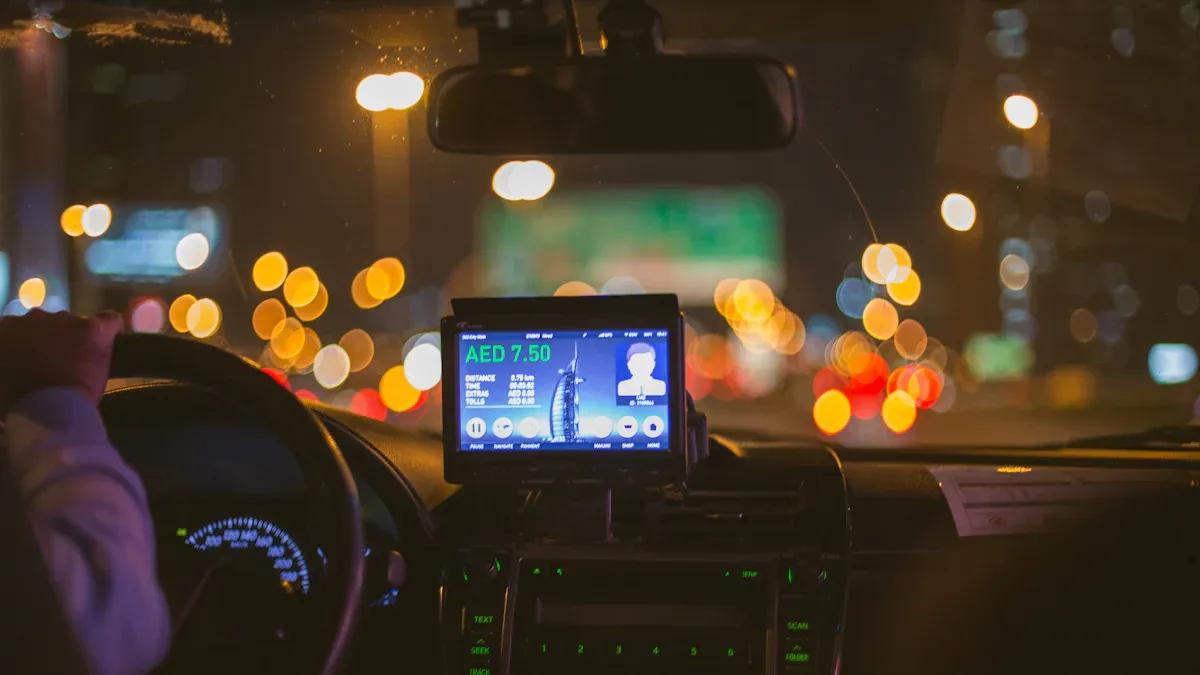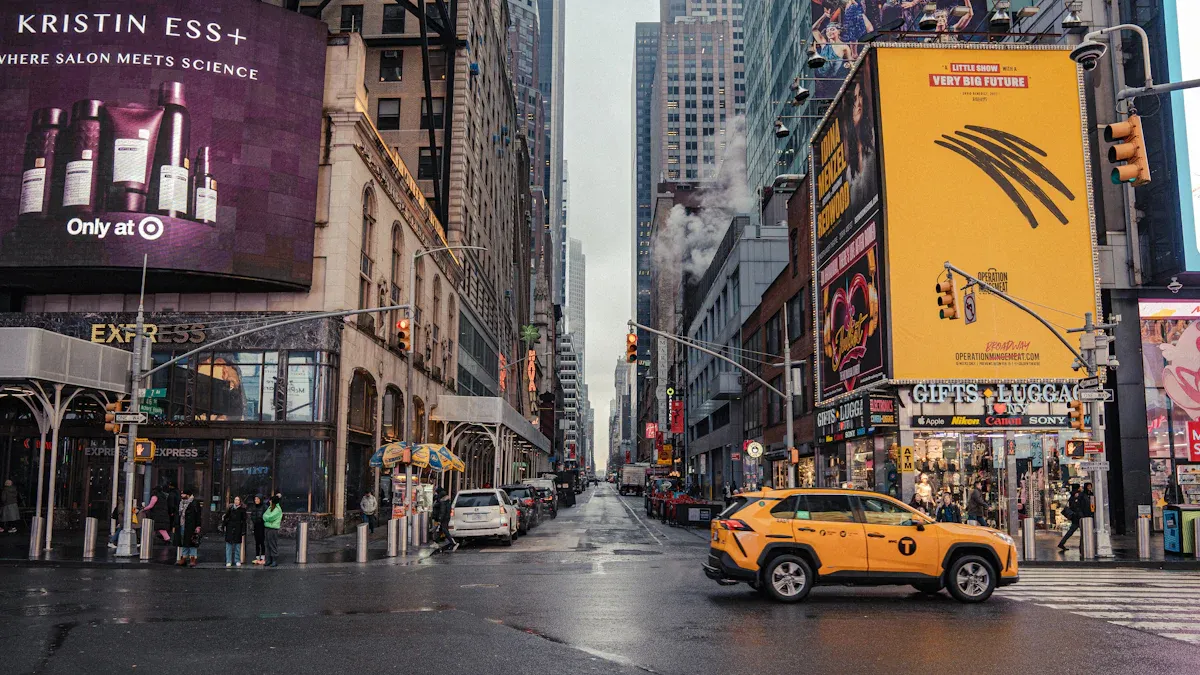
A taxi GPS-triggered advertising machine uses GPS and digital screens to show ads inside taxis. These machines watch where the taxi goes and use live data to show ads for nearby stores, news, or weather. The system uses Android tablets with GPS and 4G, so ads are easy to see and always up to date. AI helps the machines pick ads by looking at what passengers do. Advertisers get more people to see their ads, drivers make more money, and passengers get useful information. More taxis use these machines, so taxi ads reach the right people better.
Key Takeaways
Taxi advertising machines use GPS and screens to show ads. The ads change based on where the taxi is and live info. These machines help advertisers reach the right people. Drivers can make extra money with them. Passengers get helpful and fun things to see. Smart software and AI choose ads that fit the time, weather, and place. This makes ads more interesting and useful. Good connections and strong systems keep ads working well. They work even if the internet is slow or gone. Privacy and content control are big problems to solve. Companies follow rules and protect data to fix these issues.
Taxi GPS-Triggered Advertising Machine Components

Taxi Digital Signage Screens
Taxi digital signage screens are very important in 2025. These screens are inside taxis. They are usually on the back of seats or on the roof. Tablets from brands like Elo or Philips use Android. They get power from the taxi’s battery. Bigger cars might have more or larger screens. This helps everyone see the screens better. Some taxis use a media player device to play content. The screens show ads, news, and fun things to watch. Passengers can also interact with some content. The screens are bright, so people see them day and night. This helps advertisers and keeps passengers interested.
Tip: Digital signage screens show ads from many advertisers. This means more people see the ads and passengers get new content often.
Hardware Component | Description |
|---|---|
Tablets | Used in taxis, strong, use little power, often have GPS and 4G. |
Screens | Bigger or more screens for large vehicles, easier to see. |
Media Player Device | Extra device for playing content. |
Connectivity | Wi-Fi, 3G/4G for updates and data. |
Power Management | Handles power loss, keeps things working well. |
GPS and Sensors
GPS and sensors help the machine know where the taxi is. New satellites like Galileo and BeiDou give better signals. GPS works with accelerometers, gyroscopes, and magnetometers. These sensors help track the taxi even in tunnels or busy places. Artificial intelligence uses this data to fix mistakes. This makes sure ads show at the right time and place. Indoor geolocation uses Wi-Fi and Bluetooth. This helps the machine work inside buildings, so ads are always seen.
New satellites make GPS more accurate.
Many sensors work together for better tracking.
AI checks GPS data to fix problems.
Indoor geolocation helps ads show inside buildings.
These tools help show ads to people nearby.
Content Management Software
Content management software controls what shows on taxi screens. This system is in the cloud. Advertisers can change ads right away in many taxis. The software uses GPS to pick ads for each location. Advertisers can control messages from far away. This keeps ads new and up to date. Passengers can touch screens or scan QR codes to interact. Analytics tools check how well ads do. This helps advertisers make better ads. The system uses live data to update content fast. This makes taxi screens more fun and saves money.
Shows ads in real time using GPS.
Lets advertisers update ads from anywhere.
Passengers can interact with the screens.
Analytics help make ads better.
Connectivity
Connectivity keeps the machines online and updated. Taxis use strong LTE routers and special antennas. These routers switch networks to get the best signal. This works even in busy cities. The system can send many types of data at once. This lets ads, payments, and maps work together. Dual networks use both 4G/5G and Wi-Fi. This helps update ads fast and saves money. The device stores ads locally if the network stops. This keeps ads showing all the time and helps people see them.
Note: Good connectivity makes sure the right ads show at the right time. This keeps advertisers and passengers happy.
How Taxi Advertising Works

Real-Time Location Triggers
Taxi advertising machines in 2025 pick ads using real-time location triggers. They use GPS and smart targeting to know where the taxi is. The machines watch the taxi’s route and spot busy places or popular stops. Marketers use this to show ads where lots of people are. They can change ads fast by checking what riders do. The system can see what customers want right away. This helps send ads to people nearby. Campaigns use different zones and ride types, like airport trips or city rides, to control spending and messages. The system makes sure ads go to riders who might care. It avoids showing ads to people who will not respond. The machines move ad money to busy spots. This makes more people see the ads. The system keeps getting better by using data like keywords, times, and what people do. It changes ads to show at the best times.
GPS lets machines track where taxis go.
Ads switch based on live info about the taxi’s spot.
Marketers pick busy areas for better ad results.
Campaigns change on their own to match riders.
The system shows ads to the right people at the right time.
Contextual Ad Delivery
Taxi ads in 2025 use context to make ads fit better. The machines check the time, weather, and place before picking ads. In the morning, they might show coffee shop ads. If it rains, they can show umbrella or indoor activity ads. The machines use live data to change ads while they run. Advertisers can swap ads for special days or city events. This helps more people notice and like the ads. The system also uses info about where people go and busy spots to show ads better. It makes sure the right ads reach passengers when they might care most.
Time-based ads show up during busy travel hours.
Weather changes which ads appear.
Live data lets advertisers change ads fast.
Ads fit better, so more people see and like them.
Programmatic Ad Management
Programmatic ad management is important for taxi ads. The machines use live GPS data to show ads to people in certain places. Geo-fencing makes ads pop up when taxis enter or leave an area. This means ads show at the best times. Hyper-contextual targeting matches ads to what’s around the user. This makes people pay more attention. Some machines use Bluetooth beacons to find nearby devices and show local ads, even without cell service. These tricks help save money by showing ads to people who might buy something. Big brands like Starbucks and Coca Cola use these ideas to get more store visits. Programmatic ad management uses location, timing, and what users do to pick ads. This helps people notice ads and makes them work better.
Programmatic ad management helps advertisers reach the right people at the right time, making every ad count.
Interactive Features
Taxi advertising machines in 2025 have many ways for people to interact. Digital screens have touch and QR codes, so riders can join in. Passengers can look at products, play games, or get deals by touching the screen. QR codes let people scan and get offers or online services right away. Some machines let riders use their voice to ask for updates or shop online. These features make ads more fun and interesting. The machines use 5G and cloud tech to send content fast and update in real time. Analytics tools watch how people use the ads. This helps advertisers make better ads next time and see how well ads do.
Touchscreens let riders use ads and content.
QR codes give quick deals and services.
Voice features give updates and shopping.
Analytics check how people use the ads.
Interactive features help more people see and enjoy taxi ads.
Benefits of Taxi Digital Signage
For Advertisers
Taxi advertising in 2025 helps advertisers reach city people. Digital signage shows ads to the right people at the right time. Geolocation and geofencing help target ads by where taxis go. Advertisers can count how many people see their ads. They can guess how many look at them and check brand awareness. Real-time data shows which ads work best. Interactive things like QR codes get more people involved. Advertisers can quickly change ads for events or weather. This makes brands stay important and easy to see.
Benefit Category | Description |
|---|---|
Bright screens help ads stand out on busy streets. | |
Targeted Advertising | Ads reach people in shopping, business, or fun places. |
Measurable Results | GPS and analytics show how many people see and use ads. |
Dynamic Content | Advertisers update ads fast for better results. |
Cost-Effectiveness | No printing and less upkeep save money. |
Interactive Potential | QR codes and touchscreens get more people to act. |
Advertisers use taxi ads to help people remember brands and visit stores. They use data to see what works, so ads are smarter than old ones.
For Drivers
Taxi ads give drivers extra money. Digital signage pays drivers for showing ads during rides. Drivers can make more by picking busy roads or working at big events. Analytics tools show which routes get the most ad views. Drivers can change their work times to earn more. Some drivers join local deals to get more ad money. The extra cash helps drivers pay bills and earn more.
Busy roads and events help drivers earn more.
Analytics show the best times and places to drive.
Extra money helps drivers and their families.
For Passengers
Taxi ads make rides better for passengers. Digital screens show helpful ads, news, and local deals. Passengers see ads that match where they are, the time, or the weather. Interactive screens let passengers play games, scan QR codes, or get deals. This makes rides more fun and useful. Passengers learn about new stores or events nearby. The content is always new, so every ride feels special.
Passengers have a better ride with fun content and special deals made just for them.
Challenges for Taxi Advertising
Data Privacy
Data privacy is a big worry for taxi advertising in 2025. These systems collect lots of location data from every ride. This data can show where trips start and end. It might show private places like homes or clinics. Privacy experts say mixing this data with public records can show where people go. In the past, even hidden taxi trip data has been figured out to show what drivers and riders do. This means advertising platforms must work hard to keep personal info safe.
Taxi advertising often takes more data than it needs.
People do not always know what data is taken or how it is used.
There are rules, but they do not cover every problem.
People worry about how companies or the government might use or share this data later.
🚨 Privacy experts say that even “anonymous” data can sometimes show personal details when mixed with other info.
Taxi advertising companies must follow rules like GDPR and CCPA. They must keep data safe, get clear permission, and be open about what they do. These steps help passengers and drivers trust the system.
Technical Reliability
Technical reliability is very important for taxi advertising machines. If the system breaks, ads stop, and drivers and advertisers lose money. To keep things working, companies use different plans:
Preventive maintenance finds small problems before they get big.
Predictive tools and data can warn about future problems.
AI and telematics watch how things work and suggest fixes right away.
Automatic reminders help keep up with maintenance.
Spare parts or backups help fix things fast if they break.
Taxi advertising platforms also use strong electrical systems to stop power loss. These steps help keep screens working, even in busy city traffic.
Reliable systems make sure ads reach passengers without stopping.
Content Control
Content control is another problem for taxi advertising. Companies must make sure only approved ads show on screens. They need to block bad or unsafe ads. This needs strong content management software and clear rules for what can be shown.
Challenge | Solution Example |
|---|---|
Inappropriate ads | Use filters and human review |
Outdated content | Schedule regular updates |
Local regulations | Set rules for each city or region |
Taxi advertising must also follow local laws about ads. Some cities have strict rules about what can be shown in public. Companies must stay alert and update their systems to follow these rules. Good content control keeps ads safe and helpful for everyone.
Taxi GPS-triggered advertising machines in 2025 use live data and digital screens. They have smart software to show ads to the right people. These systems help advertisers reach city riders with ads that change by place and time. Drivers can make more money from these ads. Passengers get to use fun and interactive content. There are some problems, like keeping data private and making sure the machines work well. Still, more people are using these machines every year.
Aspect | Details |
|---|---|
Market Size 2023 | |
Projected 2031 | USD 250.55 million |
CAGR (2024-2031) | 5.25% |
Artificial intelligence will help make ads better by picking the best content. It will help show ads to the right people and create new ad types. AI-powered ads will use geofencing, computer vision, and real-time bidding to get better results. As ad technology gets better, taxi ads will become smarter and work better. This will give brands new ways to reach people.
FAQ
How do taxi GPS-triggered advertising machines choose which ads to show?
The system uses GPS data and live info. It checks where the taxi is, what time it is, and the weather. The software picks ads that match what is happening right now and where the taxi is.
Can passengers interact with the taxi advertising screens?
Yes, passengers can touch the screens or scan QR codes. Some screens let riders play games, get deals, or use their voice to ask for updates.
Do taxi advertising machines collect personal data?
Taxi advertising machines collect location and usage data. They do not take names or phone numbers. Companies must follow privacy laws and keep the data safe.
Note: Riders can ask how their data is used or ask for more info about privacy.
What happens if the internet connection fails?
The machine saves ads on the device. If the internet stops, the screens still show saved ads. When the connection comes back, the system updates with new ads.
How do drivers benefit from these advertising machines?
Drivers get extra money for showing ads during rides. They can earn more by driving busy routes or working at special events.
See Also
Why AI Box CarPlay Will Dominate In 2025
Best HDMI Dongles For 4K CarPlay Streaming 2025
Best Motorcycle GPS Units Supporting CarPlay And Android Auto
